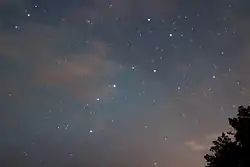Fubao
Fubao (simplified Chinese: 附宝; traditional Chinese: 附寶; pinyin: fùbǎo), a woman from the Youjiao clan,[1] was, according to Chinese mythology sources, the mother-in-law of the inventor of silk, Leizu; mother of Huang Di the Yellow Emperor; and, wife of Shaodian. However, the mythological genealogy varies. Fubao is viewed as ancestress to the Han people who form the majority of the population of China.
Daughter-in-law, Leizu
Fubao was mother-in-law to Leizu, who was the inventor of sericulture, the art of silk production, according to Chinese mythology. Silk and fabrics made from silk are some of the world's important textiles.[2] Silk is believed to have been produced since neolithic times in China. The "Silk Road" was named after the trade in silk across Eurasia.[2]
Husband, Shaodian
Fubao married Shaodian, who according to the Records of the Grand Historian, was the father of Huang Di.[3]
Son, Huang Di

Fubao was the mother of Huang Di, also called the Yellow Emperor. According to Chinese mythology, the birth was miraculous. Fubao is said to have seen a bolt of lightning (or aurora borealis) circling around one of the stars of the Great Bear (Big Dipper). The light was very bright, and she got pregnant. Twenty-four months later Fubao was said to have given birth to Huang Di.[4]
See also
Reference notes
- Etudes chinoises: bulletin de l'Association française d'études chinoises. Association française d'études chinoises. 1990. p. 142.
- Uschan, Michael V. (2014-05-09). Chinese Mythology. Greenhaven Publishing LLC. p. 33. ISBN 978-1-4205-1146-8.
- 苏叔阳 (2007). A Reader on China: An Introduction to China's History, Culture and Civilization. Better Link Press. p. 63. ISBN 978-1-60220-103-3.
- Yang, Lihui; An, Deming; Turner, Jessica Anderson (2005). Handbook of Chinese Mythology. ABC-CLIO. p. 138. ISBN 978-1-57607-806-8.